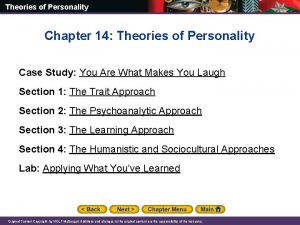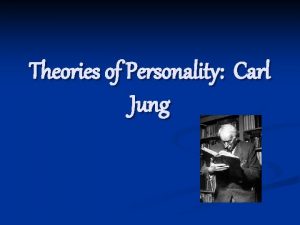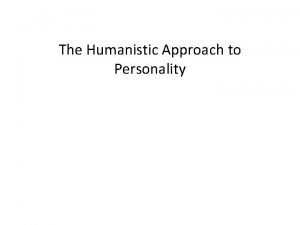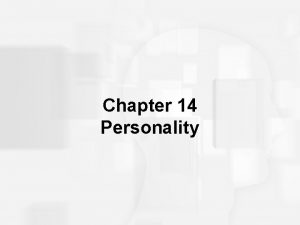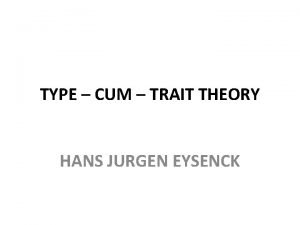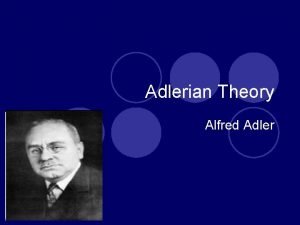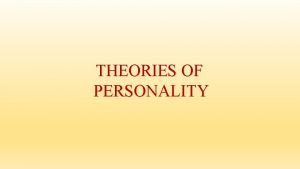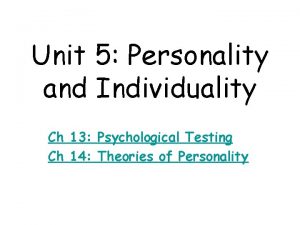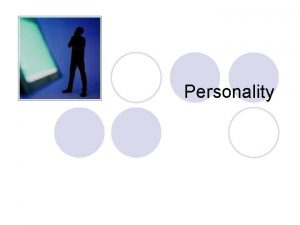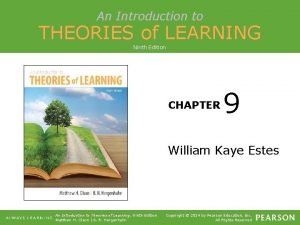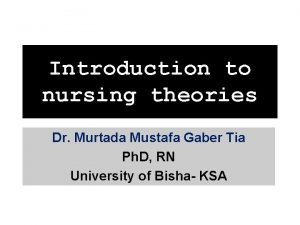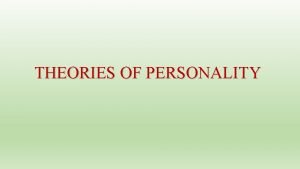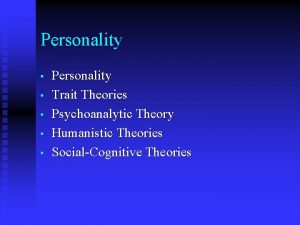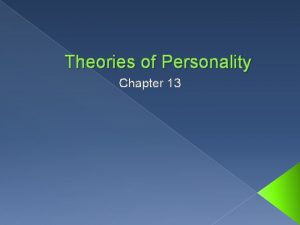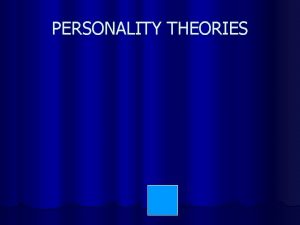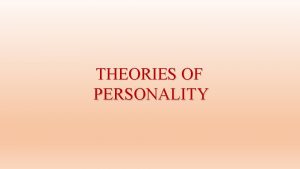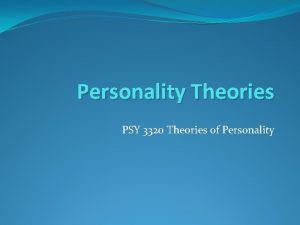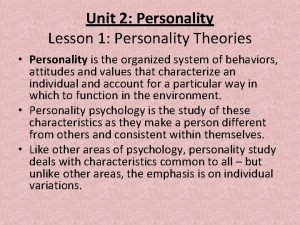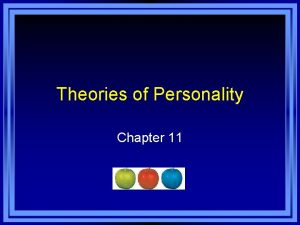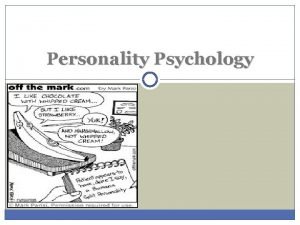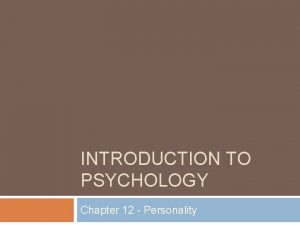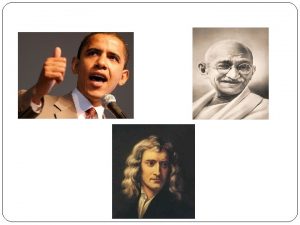Personality Part I Introduction Main Theories Personality The

















































- Slides: 49

Personality Part I – Introduction & Main Theories

Personality • The psychological qualities that bring a consistency to an individual’s thoughts and behaviors in different situations and at different times – A continuously changing process, shaped by our individual needs and cognitions and by external pressures from the social environment

Personality Type A vs. Type B – Generic description of our personalities • No research based theories – Most individuals have a combination of both types mixed throughout their specific personalities

Personality Type A Traits – Generally has a higher stress level – Enjoy achievement of goals, with greater enjoyment in achieving of more difficult goals. They are thus constantly working hard to achieve these. – Find it difficult to stop, even when they have achieved goals – Feel the pressure of time, constantly working flat out – Highly competitive and will, if necessary create competition – Hate failure and will work hard to avoid it Type B Traits – Generally lives at a lower stress level – Work steadily, enjoying achievements but not becoming stressed when they are not achieved. – When faced with competition, they do not mind losing and either enjoy the game or back down – May be creative and enjoy exploring ideas and concepts – Are often reflective, thinking about the outer and inner worlds

Personality Main Theories – Psychodynamic Theory • Developed by Sigmund Freud • Calls attention to motivation, especially unconscious motives, and the influence of our past experiences – Humanistic Theory • Emphasizes the present, “subjective reality” – What we believe is important now – what we think of ourselves in relation to others

Personality Main Theories – Social Cognitive Theory • Derived more from experiments rather than clinical work • Based on the idea that personality is a result of learning, perception and social interaction – Trait Theory • A theory that suggests our personalities are composed of various fundamental personality dimensions

Personality Psychodynamic Theory – Freud believes that the unconscious and hidden parts of the mind were a source of powerful impulses, instincts, motives, and conflicts that energize our personality – Developed this theory through psychoanalysis • Focused on how the mind’s energy is exchanged, transformed, and expressed

Personality • Freud saw human personality as an iceberg with three parts: The Ego, Superego and Id. – In this model, the Superego and the Id were antagonist parts, regulated by the Ego Conscious Mind Unconscious Mind Superego Id

Personality Psychodynamic Theory – The Id • The primitive, unconscious reservoir that houses the basic motives, drives and instinctive desires that determine our personalities. – Always acts on impulse and seeks immediate pleasure – The only part of the personality present at birth

Personality Psychodynamic Theory – The Superego • The “police” of personality and is responsible for morals and values learned from society. • Develops as a child when we form an internal set of rules based on external experiences – The inner voice of “Should” and “Should Not” – Often conflicts with the id because the id wants what feels good and the superego wants what is right and moral

Personality Psychodynamic Theory – The Ego • The conscious, rational part of the mind • Regulates the conflict between the id and the superego • Must figure out a way to satisfy one’s desires, while not violating one’s moral code. – When this balance becomes upset, conflicted thoughts and behaviors that signify a mental disorder may be the result

Personality Part II – Psychosexual Stages & Defense Mechanisms

Personality Psychosexual Stages – Freud believed that our early experiences stayed with us and affected us throughout our development, especially with regards to sex • Should something happen in the early years, people will have problems to overcome later in life specifically dealing with sexuality: – Oedipus Complex: Boy in love with their mother – Identification: Boys love their mom/identify with their dad – Penis Envy: Girls desire to have a penis-attracted to males – Fixation: Occurs when development is stopped at a particular stage

Personality Psychosexual Stages Psychosexual Stage Oral (0 -18 Months) Anal (18 -36 Months) Phallic (3 -6 Years) Latency (6 to Puberty) Genital (Puberty On) Focus Pleasure centers on the mouth – sucking, biting, chewing Pleasure focuses on bowel and bladder elimination; Coping with demands for control Pleasure zone is the genitals; Coping with incestuous sexual feelings Dormant sexual feelings Maturation of sexual interests

Personality Ego Defense Mechanisms – Ego defense mechanisms are the largely unconscious mental strategies to reduce anxiety or conflict • In other words, our unconscious mind develops strategies to deal with threatening thoughts, memories, etc.

Defense Mechanism Denial Displacement Intellectualization Projection Rationalization Description Example Arguing against an anxiety provoking stimuli by stating that it doesn’t exist Denying that your physician’s diagnosis of cancer is correct and seeking a second opinion Taking out impulses on a less threatening target Slamming a door instead of hitting a person, yelling at your spouse after an argument with your boss Avoiding unacceptable emotions by focusing on the intellectual aspects Focusing on the details of a funeral as opposed to the sadness and grief Placing unacceptable impulses in yourself onto someone else Supplying a logical or rational reason as opposed to the real reason When losing an argument, you state “You’re stupid” Stating that you were fired because you didn’t kiss up to the boss, when the real reason was your performance

Defense Mechanism Reaction Formation Regression Repression Sublimation Suppression Description Example Taking the opposite belief because the true belief causes anxiety Having a bias against a particular race or culture and then embracing that race or culture to the extreme Returning to a previous state of development Sitting in a corner and crying after hearing bad news; throwing a temper tantrum when you don’t get your way Pulling into the unconscious Forgetting sexual abuse from your childhood due to the trauma and anxiety Acting out unacceptable impulses in a socially acceptable way Becoming a surgeon because of your desire to cut; lifting weights to release ‘pent up’ energy Pushing into the unconscious Trying to forget something that causes you anxiety

Personality Neo-Freudians – Freud was a controversial figure, and many of his collogues broke away from his view, but still maintained a psychodynamic aspect to their theories • Alfred Adler – Importance of childhood social tension • Karen Horney – Sought to balance Freud’s masculine biases • Carl Jung – Emphasized the “Collective Unconscious” » Concept of a shared, inherited reservoir of memory traces from our species’ history

Personality Part III – Assessing the Unconscious

Personality • Freud and Neo-Freudians determined that certain tests needed to be created in a way that would help to “project” what was present in the unconscious

Personality • Projective Test – A personality test that provides ambiguous stimuli designed to trigger projection of one’s inner dynamics • Two Most Popular: – Thematic Apperception Test (TAT) – Rorschach’s Inkblot Test

Personality • Thematic Apperception Test (TAT) – A projective test in which people express their inner feelings and interests through the stories they make up about ambiguous scenes • Giving the subject a picture that is ambiguous (can have several meanings) and ask them what is occurring. • Their answers supposedly reveal their unconscious






Personality • Rorschach Inkblot Test – Designed by Hermann Rorschach – The most widely used projective test – A set of 10 inkblots that seek to identify people’s inner feelings by analyzing their interpretations of the blots

Personality Part IV – Humanistic & Social Cognitive Theories

Personality • Humanistic Theories – Humanistic theories are optimistic about the core of human nature • Personality is driven by needs to adapt and learn, rather than unconscious conflicts or defense mechanisms and anxiety • Mental disorders occur when a person is in an unhealthy situation that causes low self-esteem and unmet needs, not from unhealthy individuals

Personality • Abraham Maslow – Hierarchy of Needs – Believed psychology needed something that described good mental health as more than just the absence of illness – Maslow saw a group of people in pursuit of “higher ideals” and wanted a way to explain their behavior. • Self-Actualizing Personalities - Healthy individuals who have met their basic needs and are free to be creative and fulfill their potentialities

Personality • Carl Rogers – Took a different approach than Maslow – He identified healthy personalities as the fully functioning person • An individual who has a self -concept that is positive and congruent with reality

Personality • Carl Rogers • “Self” – Each person has this – How we see ourselves • “Conditions of Worth” – Love and approval based on doing what someone else likes – Can lead us to deny parts of ourselves • “Unconditional Positive Regard” – Being valued for exactly what you are • “Fully Functioning” – Not denying who we truly are – Fully accepting all of our potential

Personality • Criticisms of Humanistic Theories – Concepts are vague and subjective – Can lead to selfindulgence, selfishness, and erosion of morals – Fails to appreciate the human capacity for evil – Others?

Personality • Social Cognitive Theory – More of an emphasis on clinical research than other theories – Most well known: Albert Bandura • Observational Learning & Bobo the Clown! • Believed we are driven by: – Inner forces and the environment – Expectations about how those actions will affect other people, the environment, and ourselves.

Personality • Social Cognitive Theory – Observational Learning • We learn new responses by watching each others’ behavior – Therefore, personality is learned behavior patterns • These cognitive process involve an ongoing relationship between the individual and the environment called “Reciprocal Determinism”

Personality • Social Cognitive Theory – Locus of Control • Our sense of controlling our environments rather than feeling helpless • External Locus of Control – The perception that chance or outside forces beyond one’s control determine their fate • Internal Locus of Control – The perception that one controls one’s own fate

Personality • Criticisms of Social Cognitive Theory – Ignores heredity, emotion, and past experiences – Lacks attention to biological/hormonal processes in regards to personality – Concepts and processes are observable but very few explanations about relationships between them

Personality Part V – Trait Theories

Personality • Traits – Stable personality characteristics that are presumed to exist within the individual • These also guide his or her thoughts and actions under various conditions – Examples: • • Honest Dependable Moody Impulsive – Allport & Odbert (1936) identified over 18, 000 words representing personality traits

Personality • Traits – Allport’s Hierarchy of Traits • Cardinal Traits – Pervasive characteristics that influence behavior – Very few possess such dominant traits • Central Traits – Basic building blocks of personality that influence behavior • Secondary Traits – Superficial characteristics, such as personal preferences

Personality • Personality “Types” – Assessed by measures like the Myers-Briggs Type Indicator – Consist of a number of traits • Examples: – Feeling Type - Personality is sympathetic, appreciative, and tactful – Thinking Type - Prefers an “objective standard of truth” and is “good at analyzing”

Personality • Personality “Dimensions” – Hans and Sybil Eysenck suggested that personality could be reduced down to two polar dimensions: • Extraversion-Introversion • Emotional Stability-Instability – Believed that most personality traits, characteristics, etc. fall somewhere between these dimesnions


Personality • Personality Inventory – A questionnaire on which people respond to items designed to gauge a wide range of feelings and behaviors • Often consist of truefalse or agree-disagree items • Used to assess selected personality traits

Personality • MMPI – The Minnesota Multiphasic Personality Inventory (MMPI) – Most widely researched and clinically used of all personality tests • Was originally developed to identify emotional disorders – Problems: • Meaning attached to items may be misinterpreted • Good place to start with personality, but not a great measure by itself

Personality • The Five-Factor Theory – Suggests that personality is composed of five fundamental personality dimensions • • • Openness to experience Conscientiousness Extraversion Agreeableness Neuroticism


Personality • Positives & Negatives – Positives: • Objective and measurable • Easy to use and understand – Negatives: • Little predictive power • Does not address personality development (only present) • Does not allow for or help with change
 Rogers view of personality
Rogers view of personality Carl.jung theory
Carl.jung theory Carl rogers mbti
Carl rogers mbti Quiz on freud's psychoanalytic theory
Quiz on freud's psychoanalytic theory Compliant personality definition
Compliant personality definition Eysenck trait theory
Eysenck trait theory Adlers theory
Adlers theory Theories of personality
Theories of personality Raymond cattell was a psychologist who ________.
Raymond cattell was a psychologist who ________. L
L An introduction to theories of learning
An introduction to theories of learning Introduction to nursing theories
Introduction to nursing theories Future time will and going to
Future time will and going to Finding the main idea why were canals built?
Finding the main idea why were canals built? Void main int main
Void main int main Hát kết hợp bộ gõ cơ thể
Hát kết hợp bộ gõ cơ thể Lp html
Lp html Bổ thể
Bổ thể Tỉ lệ cơ thể trẻ em
Tỉ lệ cơ thể trẻ em Voi kéo gỗ như thế nào
Voi kéo gỗ như thế nào Glasgow thang điểm
Glasgow thang điểm Bài hát chúa yêu trần thế alleluia
Bài hát chúa yêu trần thế alleluia Môn thể thao bắt đầu bằng từ đua
Môn thể thao bắt đầu bằng từ đua Thế nào là hệ số cao nhất
Thế nào là hệ số cao nhất Các châu lục và đại dương trên thế giới
Các châu lục và đại dương trên thế giới Cong thức tính động năng
Cong thức tính động năng Trời xanh đây là của chúng ta thể thơ
Trời xanh đây là của chúng ta thể thơ Mật thư tọa độ 5x5
Mật thư tọa độ 5x5 101012 bằng
101012 bằng Phản ứng thế ankan
Phản ứng thế ankan Các châu lục và đại dương trên thế giới
Các châu lục và đại dương trên thế giới Thơ thất ngôn tứ tuyệt đường luật
Thơ thất ngôn tứ tuyệt đường luật Quá trình desamine hóa có thể tạo ra
Quá trình desamine hóa có thể tạo ra Một số thể thơ truyền thống
Một số thể thơ truyền thống Cái miệng nó xinh thế
Cái miệng nó xinh thế Vẽ hình chiếu vuông góc của vật thể sau
Vẽ hình chiếu vuông góc của vật thể sau Nguyên nhân của sự mỏi cơ sinh 8
Nguyên nhân của sự mỏi cơ sinh 8 đặc điểm cơ thể của người tối cổ
đặc điểm cơ thể của người tối cổ Giọng cùng tên là
Giọng cùng tên là Vẽ hình chiếu đứng bằng cạnh của vật thể
Vẽ hình chiếu đứng bằng cạnh của vật thể Vẽ hình chiếu vuông góc của vật thể sau
Vẽ hình chiếu vuông góc của vật thể sau Thẻ vin
Thẻ vin đại từ thay thế
đại từ thay thế điện thế nghỉ
điện thế nghỉ Tư thế ngồi viết
Tư thế ngồi viết Diễn thế sinh thái là
Diễn thế sinh thái là Dạng đột biến một nhiễm là
Dạng đột biến một nhiễm là Các số nguyên tố
Các số nguyên tố Tư thế ngồi viết
Tư thế ngồi viết Lời thề hippocrates
Lời thề hippocrates
